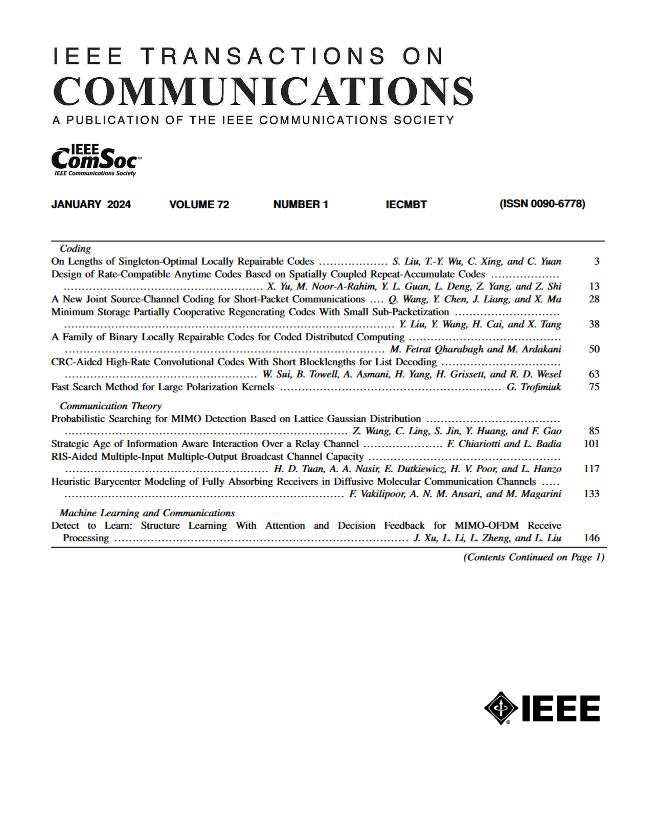基于频率选择性大规模MIMO网络的上行高负载以用户为中心的混合波束形成迭代检测方案
IF 8.3
2区 计算机科学
Q1 ENGINEERING, ELECTRICAL & ELECTRONIC
引用次数: 0
摘要
在无蜂窝(CF)网络中,接入点(ap)共同为用户设备(ue)服务。在以用户为中心(UC)的变体中,只有少数ap服务于特定的UE,即具有最佳通道的ap。在本文中,我们提出了一种用于高负载UC大规模MIMO (mMIMO)网络的混合波束形成辅助上行接收器方案,该方案工作在毫米波(mmWave)频率下,采用频率选择信道下的单载波调制。每个AP都使用自己的模拟波束形成器(AB),称为改进本征波束形成器(MEB),这促进了公平性的趋势。在数字领域,提出了两种检测器;Cell-Free迭代检测器(CFI-D)和User-Centric迭代子集检测器(UCIS-D)。CFI-D介绍了CF网络的迭代块决策反馈均衡(IB-DFE)方法。UCIS-D是CFI-D的替代方案。UCIS-D是UC,具有低计算复杂度(CCP)和可扩展性。UCIS-D依赖于并行干扰消除(PIC)辅助IB-DFE。干扰ue分为三组。弱干扰采用PIC处理,强干扰采用考虑PIC残余干扰的IB-DFE处理。最弱的干扰被忽略。PIC和IB-DFE都利用了以前迭代中的软决策。仿真结果表明,这些接收机在误码率(BER)和可达信息率(AIR)方面可以处理超高负载。本文章由计算机程序翻译,如有差异,请以英文原文为准。
Iterative Detection Schemes for Uplink Highly Loaded User-Centric Hybrid Beamforming Based Frequency Selective Massive MIMO Networks
In cell-free (CF) networks, access points (APs) jointly serve the user equipments (UEs). In user-centric (UC) variant, only a handful of APs serve a particular UE, namely the ones with the best channels. In this paper, we propose a hybrid beamforming aided uplink receiver scheme for highly loaded UC massive MIMO (mMIMO) networks, operating in millimeter-wave (mmWave) frequencies, employing single carrier modulation under frequency selective channels. Every AP employs its own analog beamformer (AB) called the modified eigen-beamformer (MEB), which promotes a trend of fairness. In the digital domain, two detectors are proposed; Cell-Free Iterative Detector (CFI-D) and User-Centric Iterative Subset-Detector (UCIS-D). CFI-D introduces the iterative block decision feedback equalization (IB-DFE) method for CF networks. UCIS-D is an alternative to CFI-D. UCIS-D is UC, has low computational complexity (CCP) and is scalable. UCIS-D relies on parallel interference cancellation (PIC) aided IB-DFE. Interfering UEs are divided into three sets. Weak interferers are processed with PIC, strong interferers with IB-DFE which considers the residual interference from PIC. Weakest interferers are ignored. Both PIC and IB-DFE utilize the soft decisions from previous iterations. Simulation results show that these receivers can handle ultra high loads in terms of bit-error-rate (BER) and achievable information rate (AIR).
求助全文
通过发布文献求助,成功后即可免费获取论文全文。
去求助
来源期刊

IEEE Transactions on Communications
工程技术-电信学
CiteScore
16.10
自引率
8.40%
发文量
528
审稿时长
4.1 months
期刊介绍:
The IEEE Transactions on Communications is dedicated to publishing high-quality manuscripts that showcase advancements in the state-of-the-art of telecommunications. Our scope encompasses all aspects of telecommunications, including telephone, telegraphy, facsimile, and television, facilitated by electromagnetic propagation methods such as radio, wire, aerial, underground, coaxial, and submarine cables, as well as waveguides, communication satellites, and lasers. We cover telecommunications in various settings, including marine, aeronautical, space, and fixed station services, addressing topics such as repeaters, radio relaying, signal storage, regeneration, error detection and correction, multiplexing, carrier techniques, communication switching systems, data communications, and communication theory. Join us in advancing the field of telecommunications through groundbreaking research and innovation.
 求助内容:
求助内容: 应助结果提醒方式:
应助结果提醒方式:


